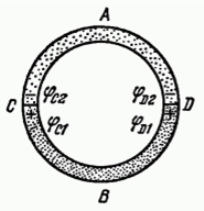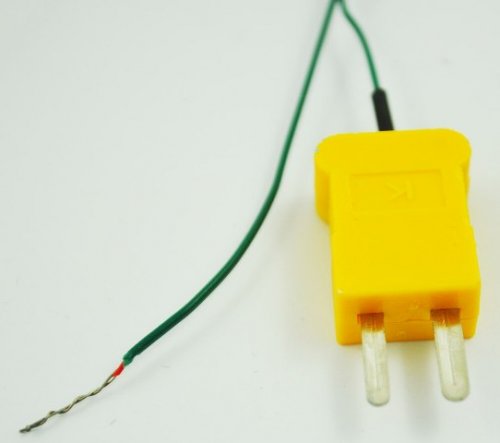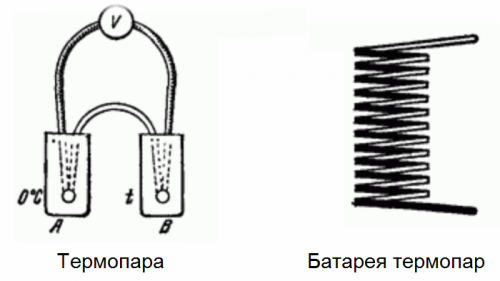Thermoelectromotive force (thermo-EMF) and its application in technology
Thermo-EMF is an electromotive force occurring in an electrical circuit consisting of series-connected uneven conductors.
The simplest circuit consisting of a conductor 1 and two identical conductors 2, the contacts between which are maintained at different temperatures T1 and T2, is shown in the figure.

Due to the temperature difference at the ends of wire 1, the average kinetic energy of charge carriers near the hot junction turns out to be greater than near the cold one. Carriers diffuse from a hot contact to a cold one, and the latter acquires a potential whose sign is determined by the sign of the carriers. A similar process takes place in the branches of the second part of the chain. The difference between these potentials is the thermo-EMF.
At the same temperature of metal wires in contact in a closed circuit, contact potential difference at the boundaries between them, it will not create any current in the circuit, but only balance the oppositely directed electron flows.
Calculating the algebraic sum of the potential differences between the contacts, it is easy to understand that it vanishes. Therefore, in this case there will be no EMF in the circuit. But what if the contact temperatures are different? Assume that contacts C and D are at different temperatures. What then? Let us first assume that the work function of electrons from metal B is less than the work function from metal A.

Let's look at this situation. Let's heat contact D — the electrons from metal B will start to transfer to metal A because actually the contact potential difference at junction D will increase due to the heat effect on it. This will happen because there are more active electrons in metal A near contact D and now they will rush to compound B.
The increased concentration of electrons near compound C initiates their movement through contact C, from metal A to metal B. Here, along metal B, the electrons will move to contact D. And if the temperature of compound D continues to be elevated relative to contact C, then in this closed circuit the directional movement of electrons will be maintained counterclockwise — a picture of the presence of an EMF will appear.
In such a closed circuit composed of dissimilar metals, the EMF resulting from the difference in contact temperatures is called thermo-EMF or thermoelectromotive force.
Thermo-EMF is directly proportional to the temperature difference between the two contacts and depends on the type of metals that make up the circuit. The electrical energy in such a circuit is actually derived from the internal energy of the heat source which maintains the temperature difference between the contacts.Of course, the EMF obtained by this method is extremely small, in metals it is measured in microvolts, the maximum is in tens of microvolts, for one degree of difference in contact temperatures.

For semiconductors, the thermo-EMF turns out to be more, for them it reaches parts of a volt per degree of temperature difference, since the concentration of electrons in the semiconductors themselves significantly depends on their temperature.
For electronic temperature measurement, use thermocouples (thermocouples)working on the principle of thermo-EMF measurement. A thermocouple consists of two dissimilar metals whose ends are soldered together. By maintaining the temperature difference between the two contacts (the junction and the free ends), the thermo-EMF is measured. The free ends play the role of a second contact here. The measuring circuit of the device is connected to the ends.
Different metals of thermocouples are chosen for different temperature ranges and with their help temperature is measured in science and technology.
Ultra-precision thermometers are made on the basis of thermocouples. With the help of thermocouples, both very low and quite high temperatures can be measured with high accuracy. Furthermore, the accuracy of the measurement ultimately depends on the accuracy of the voltmeter that measures the thermo-EMF.
The figure shows a thermocouple with two junctions. One junction is immersed in the melting snow, and the temperature of the other junction is determined using a voltmeter with a scale calibrated in degrees. To increase the sensitivity of such a thermometer, sometimes thermocouples are connected to a battery. Even very weak fluxes of radiant energy (eg from a distant star) can be measured in this way.
For practical measurements, iron-constantan, copper-constantan, chromel-alumel, etc. are most often used. As for high temperatures, they resort to vapors with platinum and its alloys - to refractory materials.
The application of thermocouples is widely accepted in automated temperature control systems in many modern industries because the thermocouple signal is electrical and can be easily interpreted by electronics that adjust the power of a particular heating device.
The opposite effect to this thermoelectric effect (called the Seebeck effect), consisting in heating one of the contacts while simultaneously cooling the other while passing a direct electric current through the circuit, is called the Peltier effect.
Both effects are used in thermoelectric generators and thermoelectric refrigerators. For more details see here:Seebeck, Peltier and Thomson thermoelectric effects and their applications


